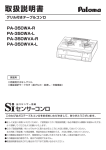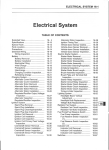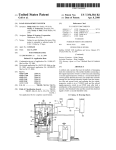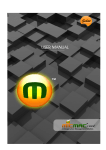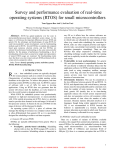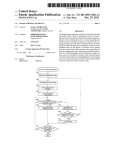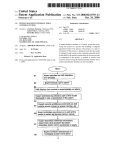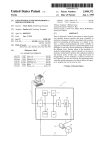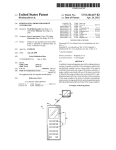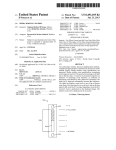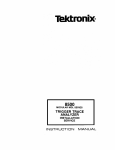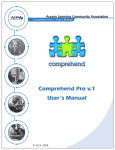Download Method and System for Managing Data in a Communication Network
Transcript
US 20130291124A1 (19) United States (12) Patent Application Publication (10) Pub. N0.: US 2013/0291124 A1 Zhao et al. (54) (43) Pub. Date: METHOD AND SYSTEM FOR MANAGING (52) DATA IN A COMMUNICATION NETWORK Oct. 31, 2013 US. Cl. CPC .............. .. G06F 21/60 (2013.01); H04L 67/02 201 3 .01 (71) Applicant: Motorola Mobility LLC, Libertyville, USPC ........................................... .. 726/28(; 709/219) IL (US) (57) ABSTRACT (72) Inventors: David Long Zhao, Bothell, WA (U S); Kevin John West, Kirkland, WA (Us); Vijay Krishnan Mani, Kenmore, WA (Us) A method for managing a plurality of ?les in a communica tion network having a plurality of clients includes a server receiving (502) metadata associated With a secured ?le stored in a virtual data drive of a ?rst client. The server also receives (21) Appl. No.: 13/929,650 (504) data segments associated With the ?le from the virtual (22) Filedi data drive of the ?rst client. The server stores the metadata and data segments associated With the ?le at the server. The server (62) Related US‘ Application Data Division of application NO_ 12/657,931, ?led on Jan 29, 2010’ HOW pat NO_ 8,510,848 J1111- 27, 2013 Publication Classi?cation (51) Int. Cl. G06F 21/60 114 (2006.01) 108 generates (506) a ?rst representation of the ?le based on the received metadata and data segments associated With the ?le and sends (508) the ?rst representation of the ?le to the plurality of clients. Next, the server receives (510) a request from a second client for at least one data segment of the ?le. The server authenticates the request based on a plurality of access rights of a user of the second client and sends (512) the at least one data segment of the ?le to the second client When the request is authenticated. 110 118 Patent Application Publication Oct. 31, 2013 Sheet 1 0f 8 US 2013/0291124 A1 Patent Application Publication $po2m3w0uM? .NowwoN wow0cm I/ / I Oct. 31, 2013 Sheet 2 0f 8 US 2013/0291124 A1 Patent Application Publication Oct. 31, 2013 Sheet 6 of 8 US 2013/0291124 A1 @3 7 Receive metadata associated with a ?le, the ?le being stored in a 502 virtual data drive‘ of a ?rst client Receive data segments associated 504 with the ?le from the virtual data drive of the ?rst client V Generate a ?rst representation of the ?le based on the received metadata and data segments associated with the ?le 506 508 Send a ?rst representation of the ?le to the plurality of clients 1 Receive a request from a second 510 client for the one or more data segment of the ?le 7 512 Send the requested one or more segment of the ?le to the second client ( Stop FIG. 5 ) Patent Application Publication Oct. 31, 2013 Sheet 7 of 8 US 2013/0291124 A1 (123 V De?ne access rights for users of 92 all clients ‘ 604 Store metadata and data segments _/ associated with a ?le Receive a change to the data 96 segments of the ?le V Update 'a ?rst representation of the ?le based on the received change to the data segments 608 / V ‘ Send the updated ?rst ' 610 representation of the ?le to all / clients V ( Stop FIG. 6 ' ) Patent Application Publication Oct. 31, 2013 Sheet 8 of 8 m V Receive a request for data 92 segments associated with a secure ?le ?om a client v Authenticate the user based on 94 ' access rights of a user of the client Did the ‘ authentication Yes of user succeed? l Stream data / segments to the 708 ( Stop FIG. 7 a ' P“ “m ) US 2013/0291124 A1 US 2013/0291124 A1 METHOD AND SYSTEM FOR MANAGING DATA IN A COMMUNICATION NETWORK REFERENCE TO RELATED APPLICATIONS [0001] The present application is a divisional of non-pro visional application Ser. No. 12/657,931 ?led Jan. 29, 2010, which claims priority from provisional application No. 61/206,588 ?led Feb. 2, 2009. Both related applications are hereby incorporated in their entirety by this reference. FIELD OF THE DISCLOSURE Oct. 31,2013 to delete ?les from the local storage to vacate space for ?les they intend to download. Thus, at every step, user’s manual intervention is requiredimaking this process entirely non seamless. [0006] In light of the foregoing, it is desirable to have a system that enables users to seamlessly store data at a remote storage without maintaining a copy of the data at the local storage. Also, the system should not require the user to manu ally download a ?le on his/her local storage every time he/ she wants to make changes to the ?le already on the remote storage. [0002] The present disclosure relates to managing data in a communication network. More speci?cally, the present dis BRIEF DESCRIPTION OF THE DRAWINGS closure relates to providing access to data stored in a remote [0007] storage using a virtual data drive. junction with the appended drawings to illustrate, and not to limit, the disclosure. Like designations denote like elements, BACKGROUND [0003] Typically, data in the form of ?les such as docu ments, image ?les, and audio/video/multimedia ?les is stored as a sequence of data bytes in a computer’s local storage, for example, the hard drive of the computer. Storing data in a local storage has a few limitations. One of such limitations is that only a restricted volume of data can be stored because of the limited capacity of the storage. For example, most of the personal computers available in market have a local storage of 40 Gigabytes (GB) to 320 GB. Another limitation is that the local storage is neither secure nor reliable because data can not be retrieved when the computer malfunctions or gets damaged. Also, if the computer is lost or stolen, data can be accessed by unauthorized users and can be misused. For example; con?dential data such as personnel details stored in a laptop can be accessed by unauthoriZed users for criminal activities. [0004] To overcome these limitations associated with the local storage, service providers enable users to store data at Embodiments of the disclosure are described in con and in which: [0008] FIG. 1 illustrates the architecture of a data manage ment system where various embodiments of the disclosure can be practiced; [0009] FIG. 2 illustrates a hierarchical representation of the data management system, in accordance with an embodiment of the disclosure; [0010] FIG. 3 illustrates the architecture of a computational device of the data management system, in accordance with an embodiment of the disclosure; [0011] FIGS. 4A-4G illustrates various embodiments of a ?rst representation and a second representation of a ?le, in accordance with an embodiment of the disclosure; [0012] FIG. 5 is a ?owchart illustrating a method for man aging a plurality of ?les in a communication network, in accordance with an embodiment of the disclosure; [0013] FIG. 6 is a ?owchart illustrating a method for man aging a server, in accordance with an embodiment of the remote storage sites connected through networks. Mostly, disclosure; and these remote storage sites are utiliZed as seamless backups or [0014] FIG. 7 is a ?owchart illustrating a method for accessing a secured ?le, in accordance with an embodiment of the disclosure. synchronization devices to maintain copies of data present in the local storage of the computer. When a ?le is created by a user in the local storage, a copy of the ?le is automatically created at the remote storage site. Similarly, when the user modi?es a ?le stored in the local storage, the same modi?ca tion is automatically made to the copy of the ?le at the remote storage site. In this scenario, if a user intends to store a 400-GB data in the remote storage, he requires a local storage of 400 GB connected to his computer. Therefore, in this case, the user may be required to connect an external hard drive to his/her computer, or may be required to upgrade the local storage of his/her computer. This requires additional expen DETAILED DESCRIPTION [0015] Before describing in detail the embodiments in accordance with the disclosure, it should be observed that these embodiments reside primarily in the method and system used for managing data in a communication network. Accord ingly, the method steps and system components have been represented to show only those speci?c details that are perti are utiliZed is non-seamless. Users having an access to the nent for an understanding of the embodiments, and not details that will be apparent to those with ordinary skill in the art. [0016] FIG. 1 illustrates the architecture of a data manage ment system 100 where various embodiments of the disclo sure can be practiced. Data management system 100 is imple remote storage sites manually upload and download data to and from the remote storage sites. In this scenario, only the mented over a communication network 102. Examples of communication network 102 include a Local Area Network downloaded data is stored in the local storage “of the com puter. Also, in this case, if the user intends to make modi? cloud computing network, high speed cable network, and the diture and hence is not an e?icient way to store a large amount of data. [0005] Another manner in which the remote storage sites cation to an already uploaded ?le, he/ she has to manually download the ?le on the local storage and then make changes to it. Therefore, he/ she has to upload the modi?ed ?le on the remote storage site again. Also, in the case of remote storage sites, users have to continuously keep track of the free space available in the local storage of their computers as they need (LAN), a Wide Area Network (WAN), cellular network, Internet. Communication network 102 includes a server 104 connected to a remote storage 106. In accordance with one implementation, server 104 is a stand-alone server connected to remote storage 1 06. In accordance with another implemen tation, server 104 is a cluster of servers connected to remote storage 106. Examples of server 104 include, but not limited US 2013/0291124 A1 to, a MySQL Amazon EC2®, and Ruby on Rails®. Example of remote storage includes, but is not limited, to Amazon S3®. [0017] Data management system 100 includes one or more clients connected to communication network 102. These cli ents are shoWn as a ?rst client 108 and a second client 110 in FIG. 1. Oct. 31,2013 of the music ?le may include metadata associated With the music ?le, and the ?rst and last data segments of the music ?le. Examples of the metadata include siZe of the music ?le, artist name, song name, album name, composer name, offset of the music ?le in the remote storage, and date of creation of the music ?le. In accordance With another implementation, the ?rst representation of the ?le does not include any meta In the description of the present patent application, data or data segment associated With the ?le. In this case, the the term “clients” refers to computer program applications ?rst representation can be, for example, only the name of the music ?le and the like. [0018] installed to access data stored at remote storage 106. As depicted, ?rst client 108 and second client 110 are installed on a computational device having a local storage, shoWn as a ?rst computational device 112 having a ?rst local storage 114 and a second computation device 116 having a second local stor age 118. Examples of computational devices include, but are [0023] In accordance With an embodiment of the disclo sure, the ?rst representation of the ?le is determined by server 104 based on a set of attributes related to the ?le. For example, the set of attributes may include name, siZe of the ?le, content or content overvieW of the ?le, timestamp of creation, and not limited to, a computer, a laptop, a personnel data assistant timestamp of modi?cation. Also, the ?rst representation of (PDA), and a mobile phone. Examples of local storage the ?le determines the format in Which ?rst client 108 and second client 110 store the ?le in their corresponding local storages. For example, if the ?le contains an image, the ?rst representation of the ?le can be a copy of the image having a loWer resolution. [0024] In accordance With an embodiment of the disclo sure, the ?rst representation of the ?le is treated as a valid include, but are not limited to, a hard disk and a solid-state drive. In accordance With another embodiment, local storage may comprise a metadata store and a data store such that metadata associated With a ?le is stored in the metadata store of the local storage and data segments associated With the ?le are stored in the data store of the local storage. [0019] As mentioned, ?rst client 108 and second client 110 are applications running on ?rst computational device 112 and second computation device 116, respectively. In one example, client 108 is a Web broWser. In another example, system ?le object by applications installed on computational devices 112 and 116 i.e. applications can use the ?rst repre sentation of the ?le as a valid form of the ?le. For example, if client 108 is a standalone-client application based on JAVA. the ?rst representation of an image ?le is a thumbnail, then the thumbnail can be accessed by a “Picture VieWer” application Further, operating systems such as WindoWs®, Linux, and in the same Way as “Picture VieWer” accesses the image ?le. Macintosh® (Mac) are installed on computational devices 112 and 116. [0020] First client 108 enables computational device 112 to communicate With server 104 and receive data stored in remote storage 106. Further, client 108 enables its user to upload a ?le on remote storage 106 by placing the ?le in a virtual data drive of ?rst client 108. In accordance With an embodiment of the disclosure, the virtual data drive is a shortcut in the form of an icon that can be used to upload one or more ?les to server 104. For example, if ?rst client 108 runs on the Microsoft® Windows@ operating system, the virtual data drive is displayed With other data drives, such as a C drive or a D drive. When the user of ?rst client 108 places a ?le in the virtual data drive of ?rst client 108, the data segments and metadata associated With the ?le are transferred from local storage 114 to remote storage 106. Based on the received metadata and data segments, server 104 generates a ?rst rep resentation of the ?le and sends a message describing the ?rst [0025] Once the ?rst representation is received by ?rst cli ent 108 and second client 110, either of the clients can send a request to server 104 to access the uploaded ?le if it is not available in corresponding local storage. For example, if the uploaded ?le is a song and after vieWing the ?rst representa tion of the song, the user of second client 110 Wants to vieW the entire song, he/ she can send a request to server 104 to listen to the song. Thereafter, server 104 receives this request from second client 110 and grants the user access to the song if he/ she has access rights to vieW the song. In this case, server 104 streams data segments associated With the song from remote storage 106 to second client 110. According to an embodiment, one or more data segments associated With the ?le are streamed from remote storage 106 and stored at local storage 118 of second client 110 if the request is not for a “secured ?le”. For example, if While uploading the song to remote storage 106, the user of ?rst client 108 does not classify the song as a “secured ?le”, the song is cached at local representation of the ?le to clients 108 and 110. On receiving storage 118 of second client 110 When second client 110 gets the message from server 104, second client 110 stores the ?rst access to the song. HoWever, if the user of ?rst client 108 classi?es the song as a “secured ?le”, the song is not cached at local storage 118 of second client 110. In this case, second client 110 only stores basic metadata such as ?le name and ?le representation of the ?le in local storage 118 and ?rst client 108 stores it in local storage 114. [0021] In accordance With another embodiment, ?rst client 108 can also generate a default ?rst representation of the ?le uploaded to remote storage 106. In this case, the ?rst repre sentation of the ?le is not sent to ?rst client 108 by server 104, and only sent to second client 110. [0022] The ?rst representation of the ?le has a smaller siZe as compared With the siZe of the ?le. Typically, the ?rst representation of the ?le includes metadata associated With the ?le. The metadata associated With the ?le includes data related to the hierarchy of directories associated With the ?le. In one implementation of the disclosure, the ?rst representa tion also includes some data segments associated With the ?le. For example, if the ?le is a music ?le, the ?rst representation creation timestamp in local storage 118. [0026] HoWever, if the ?le (movie song) is available in local storage 118 of second client 110, the request to server 104 is not sent and the ?le already stored in local storage 118 is provided to second client 110. In other Words, second client 110 only requests for ?les Which are not saved or cached in its local storage 118. [0027] In accordance With an embodiment of the disclo sure, the number of data segments cached at local storage 118 of second client 110 is based on one or more parameters of the communication netWork. The one or more parameters include, but are not limited to, bandWidth of the communica US 2013/0291124 A1 tion network and connection speed. For example, When sec Oct. 31,2013 up as much storage as the siZe of the music ?le even though its ond client 110 is connected to server 104 through a cellular data segments may be organiZed differently based on the network, the number of data segments being transferred by nature in Which the ?le Was read. server 104 and subsequently cached in local storage 118 of second client 110 is less than the number of data segments transferred by server 104 and subsequently cached in local storage 118 When second client 110 is connected to server 104 through a high-speed cable connection. [0028] In accordance With another embodiment, one or more data segments associated With the ?le are synchro nously accessed from remote storage 106 for the user using ?rst client 108. For example, a user of ?rst client 108 can request access to a document Which is being edited by a user [0033] Server 104 is further con?gured to generate the ?rst representation of a ?le When the ?le is modi?ed in remote storage 106. For example, if second client 110 modi?es a ?le stored at remote storage 106, server 104 determines an updated ?rst representation of the ?le and sends it to ?rst client 108 and second client 110. [0034] In accordance With another example, server 104 is con?gured to alloW o?line access to a ?le such that second client 110 can request Which ?les it Will require for of?ine of second client 110. The changes being made to the docu access. In this case, server 104 Would send the requested ?les to second client 110. For example, a user of second client 110 ment by the user of second client 110 are received by server may Wish to access a music ?le for later use When second 104 that further updates the document correspondingly. client 110 Will not be connected (in the future) to communi Server 104 also sends the updated document for access to the user of ?rst client 108. Thus, the user of ?rst client 108 can cation netWork 100. In this case, server 104 provides the entire music ?le to local storage 118 of second client 110 so that the user can play the music ?le even When second client 110 is not connected to communication netWork 100. [0035] In accordance With an embodiment, each user should have the access rights to’ clients 108 and 110 to be able synchronously access the document being changed by the user of second client 110. [0029] In accordance With an embodiment of the disclo sure, if the ?le requested by second client 110 is a media ?le, only the data segments Which are not included in the ?rst representation of the ?le are sent to second client 110. For example, if the ?rst representation (Which is already stored in local storage 118 of second client 110) has the ?rst and last data segments of the song, only the remaining data segments are sent to second client 110. On the contrary, if the ?le is a document, the ?rst representation of the document includes metadata associated With the document and all the data seg ments are sent to second client 110 in this case. [0030] In accordance With another embodiment, if feW data segments are already present in local storage 118 of second client 110, those data segments are not requested by second client 110 While sending the request to server 104 and only remaining data segments are requested. For example, if some to access or upload ?les to and from server 104. Server 104 is con?gured to create accounts for each user and de?ne access rights to users of clients 108 and 110. Based on the account, server 104 is further con?gured to authenticate users of cli ents 108 and 110. An account is created for a user by server 104 When the user signs-up With server 104. The user account is created by supplying a usemame and a passWord along With additional personal information such as name, date of birth, sex, and country. Access rights include a combination of the right to upload ?les to the server, the right to read or modify ?les, the right to delete ?les, and the like. of the data segments of a song are already saved or cached in [0036] In accordance With an embodiment of the disclo sure, a ?le uploaded by a user of ?rst client 108 into the virtual data drive of ?rst client 108 is not removed from local storage 114 unless there is need to free up space in local storage 114. local storage 118, only the remaining data segments of the In this case, the ?le is kept in local storage 114 of ?rst client song are requested by second client 110. [0031] On receiving the data segments, according to one example, second client 110 adds the received data segments the ?rst representation of the ?le generated by server 104 is 108 and uploaded to server 104 as Well. Further, in this case, to the ?rst representation of the ?le to create a second repre sentation of the ?le. In one embodiment, second client 110 also received by ?rst client 108, although it already has the uploaded ?le. [0037] Although the above description relates to uploading receives all data segments associated With the ?le and replaces the ?rst representation of the ?le With the second representation of the ?le in local storage 118. In this case, the second representation of the ?le is a complete ?le, i.e., all the a ?le in remote storage 106 by saving the ?le in a virtual drive, in accordance With an embodiment of the disclosure, data segments associated With the ?le can automatically be trans ferred to remote storage 106 to free memory in local storage data segments associated With the ?le are stored in local 114 for neW ?les. For example, a user uploads a video movie storage 118. [0032] In accordance With another embodiment, client 110 ?le to the virtual data drive Which already has a number of song ?les stored in it. Once the song ?les stored in the virtual data drive have been transferred to remote storage 106 they can be removed from local storage 114 to free space for the video movie ?le. is con?gured to send a request to server 104 for a “random” access of a ?le. For example, the virtual data drive enables second client 110 to randomly access a particular data seg ment associated With the ?le Without doWnloading all the data segments associated With the ?le starting from the beginning. For example, When a user of client 110 Wants to play a music ?le in a media player, he/ she may jump to the middle of the song. In this case, second client 110 requests for data seg ments located in the middle of the sequence of data segments of the song. Thus, data segments from the middle of the song [0038] FIG. 2 illustrates the hierarchical representation of data management system 100, in accordance With an embodi ment. Data management system 100 is implemented over server 104 connected to computational device 112 via com munication netWork 102. Computational device 112 includes client 108 connected to local storage 114. Server 104 is con nected to remote storage 106. are streamed from remote storage 106 to second client 110. In [0039] other Words, if the user decides to play the initial portions of the music ?le, then second client 110 requests only the nec essary data segments and creates a “chunk ?le” that only takes to server 104, the user has to sign-up With server 104. By signing-up With server 104, a user account is created for the user With a username and passWord along With additional Before a user ofclient108 can access or upload ?les US 2013/0291124 A1 personal information. Each user account is provided With access rights by a rights manager 208. Access rights provided by rights manager 208 may include a combination of the right to upload ?les to the server, the right to read or modify ?les, the right to delete ?les, and the like. [0040] In accordance With an embodiment, to upload a ?le in remote storage 106, a user of client 108 uploads a ?le into a virtual data drive of computational device 112. Metadata and data segments associated With the ?le uploaded into the virtual data drive are received by a receiver 202 of server 104. The metadata associated With the ?le includes, but is not limited to, data related to the hierarchy of directories associ ated With the ?le and ?le attributes. For example, if a user uploads a song ?le using the virtual data drive of computation device 112, the metadata of the song can include the size of the ?le, artist name, track name, etc. [0041] After receiving the metadata and data segments associated With the ?le, a processor 204 of server 104 gener ates a ?rst representation of the ?le based on the metadata and data segments received by receiver 202. The ?rst representa tion of the ?le is smaller in size as compared With that of the ?le. In the example, the ?rst representation of the song ?le can be the artist name, track name, and the starting and ending segments of the song. [0042] A sender 206 of server 104 sends the ?rst represen tation of the ?le to all clients (not shoWn in FIG. 2) present in the communication network. In the embodiment shoWn in FIG. 2, sender 206 sends the ?rst representation of the ?le to Oct. 31,2013 remote storage 106. Receiver 202 of server 104 receives the request. Processor 204 of server 104 processes the request and instructs sender 206 of server 104 to send the requested data segments of the ?le to client 108. The user can then modify the one or more data segments. The modi?ed data segments are sent back to server 104 by a sync manager 210. Receiver 202 of server 104 receives the modi?ed data seg ments and processor 204 updates the ?rst representation of the ?le based on the modi?ed data segments. Sync manager 210 of client 108 then synchronizes and updates the ?rst representation of the ?le stored in local storage 114 With the ?rst representation of the ?le stored at remote storage 106 of server 104. The updated ?rst representation of the ?le is then sent by sender 206 to all clients connected to server 104. For example, a user may modify an image stored in remote stor age 106 of server 104. Sender 206 provides the image to client 108 of computational device 112 to enable editing by the user. The edited image is updated in remote storage 106 of server 104. Processor 204 of server 104 updates the ?rst represen tation of the image and sync manager 210 of client 108 synchronizes the ?rst representation of the image stored in local storage 114 of client 108 With the updated ?rst repre sentation of the image provided by server 104. [0046] In accordance With yet another example, the user of client 108 requests to enable access to one or more data segments of a secured ?le. Client 108 sends a request to server 104 to enable access to the one or more data segments of a client 108. When the 10 ?rst representation is received, it is secured ?le stored in remote storage 106. For example, the stored in local storage 114 associated With client 108 of user of computational device 112 may Wish secure access to a ?nancial document. In this case, client 108 sends a request to server 104 for secure access to the ?nancial document and computational device 112. [0043] After receiving the ?rst representation and vieWing it, the user of client 108 may Want to vieW the entire ?le or some part of it. In this case, the user of client 108 requests this request is received by receiver 202. access to one or more data segments of the ?le. Client 108 of server 104, and processor 204 in turn sends a request to checks if the requested data segments of the ?le are available in local storage 114. If the requested data segments are avail able in local storage 114, client 108 provides the requested data segments of the ?le to the user. If the requested data segments are not available in local storage 114, client 108 sends a request to server 104 to access the one or more data segments of the ?le stored in remote storage 106. In the previous example, the user may Wish to play the song ?le. Client 108 checks if the song ?le is available for playback in local storage 114. If it is not available, client 108 sends a request to server 104 for playing the song ?le. [0044] Receiver 202 of server 104 receives this request. Processor 204 of server 104 processes the request and instructs sender 206 of server 104 to establish a streaming connection With a streamer 214 of client 108 and begin streaming the requested data segments of the ?le. A cache [0047] The received request is processed by processor 204 rights manager 208 for authenticating the user of client 108 based on the access rights of the user. If rights manager 208 authenticates the user, sender 206 is authorized to send the requested data segments of the secured ?le to client 108. In an embodiment, the requested data segments are directly streamed to streamer 214 of client 108 Without being cached by cache manager 212 or stored by local storage 114 of client 108. In the example, if the user has access rights to the ?nancial document, then server 104 provides secure access to the ?nancial document and does not cache the ?nancial docu ment in local storage 114. In other Words, the ?nancial docu ment bypasses local storage 114 and is directly streamed to client 108. [0048] In accordance With another embodiment of the dis closure, the user of client 108 can also modify one or more manager 212 associated With client 108 receives the streamed data segments of the ?le from sender 206 of server 104 to enable access by the user of computational device 112. In the example, the user Wants to play the song ?le Which is stored in remote storage 106 of server 104. Streamer 214 of the client receives the stream of data segments of the song ?le from sender 206 of server 104 and cache manager 212 of client 108 begins to catch the stream of data segments of the song ?le for data segments of a secured ?le by similar means and the updated ?rst representation is then sent to all the clients of communication netWork 102. playback by computational device 112. tem. In FIG. 3, computational device 112 is depicted running on Windows@ operating system and computational device 116 running on Macintosh® operating system. As clients 108 and 110 are applications implemented using JAVA, they can [0045] In another example, the user of computational device 112 can modify one or more data segments of the ?le. In this case, client 108 sends a request to server 104 for modifying one or more data segments of the ?le stored in [0049] FIG. 3 illustrates the architecture of computational devices 112 and 116 of data management system 100, in accordance With an embodiment of the disclosure. Typically, computational devices 112 and 1.16 are computers that run a Windows@ operating system or a Macintosh® operating sys be installed on both computational devices 112 and 116 and US 2013/0291124 A1 can enable computational devices 112 and 116 to establish a communication link With server 104 and access the ?les stored in remote storage 106. [0050] As depicted, computational device 112 includes cli ent 108, a WindoWs explorer extension module 301, a Win doWs ?le system API module 302, and a Remote procedure Oct. 31,2013 sure, cache manager 322 receives all data segments associ ated With the ?le and replaces the ?rst representation of the ?le With all data segments of the ?le. Further, data streamers 324 are con?gured to doWnload data segments from remote storage 106. In one example, data streamers 324 doWnload data segments as multiple streams of data. call (RPC) module 304. WindoWs explorer extension module [0056] 301 provides additional functionalities to the user of client Similarly, client 110 includes a File system layer 108 by providing additional control elements. Examples of 326, a Shell API module 328, a Sync Manager 330, a Cache Manager 332, and data streamers 334. The functionalities of the control elements include buttons, menu items, and icon these elements are the same as those explained for client 108, overlays. WindoWs ?le system application programming and hence are not described again for the sake of simplicity. [0057] FIGS. 4A-4G illustrate various embodiments of a ?rst representation and a second representation of a ?le, in accordance With an embodiment of the disclosure. As already discussed, When client 108 uploads a ?le on remote storage 106, client 108 transfers metadata and data segments associ ated With the ?le from local storage 114 to remote storage 106. Thereafter, server 104 generates a ?rst representation of the ?le based on the received metadata and data segments associated With the ?le, and sends the representation to the clients 108 and 110. Clients 108 and 110 then store the ?rst interface (API) module 302 facilitates the interception of the requests generated for accessing ?les. The requests are gen erated by the applications running on computational device 112. Further, WindoWs ?le systemAPI module 302 facilitates direction of these requests to client 108. [0051] Similarly, computational device 116 includes client 110, a Mac Finder extensions module 308, a Mac ?le system API module 310, and a Remote procedure call (RPC) module 312. The Mac Finder extensions module 308 provides addi tional functionalities to the user of client 110 by providing neW control elements. Examples of the neW control elements include neW buttons, menu items, and icon overlays. The Mac ?le system API module 310 facilitates the interception of the requests generated to access ?les. The requests are generated by the applications running on computational device 112. Further, Mac ?le system API module 310 facilitates direction of these requests to client 110. [0052] In one embodiment, client 108 includes a File sys tem layer 316, a ShellAPI module 318, a Sync Manager 320, a Cache Manager 322, and data streamers 324. The requests directed to client 108 by WindoWs ?le system API module 302 are handled by File system layer 316. File system layer 316 also enables computational device 112 to perform vari ous operations on the ?les stored in remote storage 106. Examples of the various operations include opening a ?le, reading a ?le, seeking a ?le, creating a ?le, and modifying a ?le. representation of the ?le in their respective local storages Subsequently, to access the ?le stored in remote storage 106, client 110 can generate a request for one or more data seg ments of the ?le based on the ?rst representation of the ?le. The request received by server 104 is processed by processor 204 of server 104, and the requested one or more data seg ments of the ?le are sent to client 110. Client 110 receives the requested one or more data segments of the ?le and generates a second representation of the ?le by adding the received one or more data segments of the ?le to the ?rst representation of the ?le. For example, if a user uploads an image ?le to server 104 via client 108 such as an “image vieWer” application softWare (for example IrfanVieW®), the server creates a thumbnail of the image ?le as the ?rst representation of the image ?le and sends the thumbnail of the image ?le to clients 108. and 110. When the user clicks on the thumbnail, a request is sent to the server to receive the image ?le. The [0053] Extension calls generated by WindoWs explorer image ?le is received by the “image vieWer” and displayed to extension module 301 for providing the additional control the user. elements to the user of client 108 are handled by Shell API module 318. [0054] Sync Manager 320 facilitates the synchronization of client 108 With server 104. During the synchronization, Sync Manager 320 detects and uploads neWly created ?les to remote storage 106. Further, Sync manager 320 uploads the metadata associated With the ?les that are placed in the virtual data drive of client 108. Modi?cations made to these ?les are uploaded by Sync Manager 320. Sync Manager 320 is further [0058] FIG. 4A illustrates a ?rst representation of the ?le as stored in local storage 114. The ?rst representation includes the metadata related to the ?le. The data segments associated With the ?le are stored at remote storage 106. For example, if the ?le being uploaded is a document, metadata such as ?le name, time stamp of creation, timestamp of modi?cation, and reference to the document is stored in local storage 114. [0059] FIG. 4B illustrates a second representation of the ?le. In this representation, all data segments associated With con?gured to send periodic requests to server 104 for doWn loading modi?cations made by other clients on the ?les that are stored in local storage 114. Sync Manager 320 can thus the ?le are received from remote storage 106 and stored in local storage 114. In another embodiment, a subset of the data doWnload the updated ?rst representation of the modi?ed ?les segments associated With the ?le is stored in local storage and can also doWnload the entire modi?ed ?le to provide 114. o?line access to the ?le. [0060] FIG. 4C illustrates another form of the ?rst repre sentation of the ?le stored in local storage 114. This repre sentation includes the ?rst data segment of the ?le, the last data segment of the ?le and metadata related to the ?le. The remaining data segments of the ?le are stored in remote storage 106. For example, if the ?le being uploaded is a music ?le, the ?rst data segment of the music ?le, the last data segment of the music ?le, and the metadata related to the music ?le are stored as the ?rst representation in local storage 118. [0055] Cache Manager 322 is con?gured to store the ?rst representation of a ?le in local storage 114 based on the message received from server 104. The ?rst representation of the ?le is either stored automatically or on a request by the user. Moreover, Cache manager 322 is con?gured to receive data segments associated With the ?le from remote storage 106. On receiving the data segments, cache manager 322 transforms the ?rst representation of the ?le to the second representation of the ?le. In one embodiment of the disclo US 2013/0291124 A1 Oct. 31,2013 [0061] In accordance With another implementation, a com pressed version of the ?le is stored With metadata as the ?rst The ?rst representation of the ?le is also generated based on representation in local storage 114. For example, if the ?le is rules. The set of attributes may include siZe of the ?le, content an image, a copy of the image having a loWer resolution is stored in local storage 114. [0062] FIG. 4D illustrates another form of the second rep resentation of the ?le. This representation includes a begin of the ?le, timestamps of creation, and timestamp of modi? ning metadata, all the data segments of the ?le, and the ending metadata of the ?le. For example, if the ?le is a music ?le, the beginning metadata related to the music ?le, all of the data segments of the music ?le and the ending metadata related to the music ?le are stored as the ?rst representation in local storage 118. [0063] FIG. 4E illustrates yet another form of the ?rst rep resentation of the ?le. This representation includes a begin ning metadata, partial data segments of the ?le, and the end a set of attributes related to the ?le and a set of prede?ned cation. Processor 204 also alloWs the user of client 108 (Who uploads the ?le) to customiZe a set of prede?ned rules for generating the ?rst representation of the ?le. The prede?ned rules include, but are not limited to, a combination of one or more attributes related to the ?le, such as type of ?le. As an example, a ?rst representation of an image ?le is a com pressed image smaller than the actual image and information about the author of the image. The user can customiZe this ?rst representation of the ?le such that the ?rst representation of the image ?le contains a thumbnail of the image ?le. [0068] At step 508, sender 206 of server 104 sends the ?rst ing metadata of the ?le. For example, if the ?le is a music ?le, the beginning metadata related to the music ?le, partial data segments of the music ?le and the ending metadata related to representation of the ?le to clients 108 and 110 connected to server 104. Based on the received ?rst representation, client 110 stores the ?rst representation of the ?le in its local storage 118 and client 108 stores it in its local storage 114. After the music ?le are stored as the ?rst representation in local receiving the ?rst representation of the ?le, client 110 can storage 118. [0064] FIG. 4F illustrates yet another form of the second representation of the ?le. The second representation includes the ?rst data segment of the ?le, the last data segment of the ?le, and remaining data segments of the ?le that are received from remote storage 106. Consider the example of the music ?le again. When computational device 116 launches a music player for playing the music ?le stored in remote storage 106, the player plays the ?rst data segment of the music ?le as the ?rst data segment is stored in local storage 118. While the ?rst generate a request to access the data’ segments of the ?le based on the ?rst representation of the ?le. Client 110 checks data segment is being played, the remaining data segments associated With the music ?le are continuously streamed from remote storage 106 and played as soon’ as playing of the ?rst data segment is over. As the rate of streaming data segments is higher than the rate at Which the music ?le is played, the music ?le is continuously played Without any latency. As a result, the user feels as if the music ?le is stored locally in local storage 118. [0065] FIG. 4G illustrates yet another form of the second representation of the ?le. In this case, the second representa tion includes the ?rst data segment of the ?le, the last data segment of the ?le and the remaining data segments. As depicted, the data segments of the ?le are not sequentially stored in local storage 118. For example, the remaining data segments are stored before the ?rst data segment in the case shoWn in FIG. 4G. When the user accesses the ?le, the virtual data drive enables the user to access the data segments in the correct sequence, irrespective of the sequence in Which they are stored. [0066] FIG. 5 is a ?owchart illustrating a method for man aging a plurality of ?les in a communication netWork, in accordance With an embodiment of the disclosure. At step 502, metadata associated With a ?le, uploaded or saved by a user for storage in the virtual data drive of client 108, is received by receiver 202 of server 104. The metadata associ ated With the ?le includes, but is not limited to, metadata related to the hierarchy of directories associated With the ?le, ?le name, ?le creation timestamp, ?le modi?cation times tamp, siZe of the ?le, and content type of the ?le. Whether the requested data segments associated With the ?le are present in local storage 118 (either saved or cached if the ?le Was earlier accessed by client 110). Consider the example of a music ?le. When the music player is launched, client 110 checks Whether the requested portions of the music ?le are already stored or cached in local storage 118. Client 110 accesses the requested data segments of the ?le When the requested data segments are stored or cached in local storage 118. The music player gets the access to the requested por tions of the music ?le When they are stored or cached in local storage 118. If the requested data segments are not stored in local storage, client 110 generates a request based on the ?rst representation of the ?le and sends the request to server 104. For example, When a user desires to vieW the image ?le using an application such as a’ “Picture vieWer”, the compressed version of the ?le, i.e., a copy of the image ?le With loWer resolution, is immediately displayed in the picture vieWer. To improve the resolution of the displayed image, client 110 may send a request to server 104 for streaming the remaining data segments from remote storage 106 to local storage 118. [0069] At step 510, receiver 202 of server 104 receives a request for access to one or more data segments of the ?le from client 110. [0070] At step 512, sender 206 of server 104 sends the requested one or more data segments of the ?le to client 110. On receiving the stream of the requested data segments of the ?le from sender 206, the ?rst representation of the ?le is transformed into a second representation of the ?le and pro vided to the user. In the example, the image ?le is received and displayed in the picture vieWer. In another implementation, on receiving the remaining data segments, client 110 appends the received data segments With the ?rst representation of the ?le. Consider the example of the music ?le Where the ?rst representation of the music ?le includes metadata associated With the music ?le, the ?rst data segment of the music ?le, and the last data segment of the music ?le stored in local storage 118. When the user launches a music player to play the music At step 504, data segments associated With the ?le ?le, the ?rst data segment stored in local storage 118 is saved in the virtual drive of client 1 08 are received by receiver 202 of server 104. At step 506, processor 204 of server 104 While, client. 110 sends a request to server 104 for streaming generates a ?rst representation of the ?le, based on the received metadata and data segments associated With the ?le. As the remaining data segments are streamed from remote [0067] accessed by client 110 and played by the music player. Mean the remaining data segments associated With the music ?le. US 2013/0291124 A1 storage 106 to local storage 118, the remaining data segments are continuously played by the music player. Client 110 accesses the second representation of the music ?le, which includes the requested data segments associated with the music ?le. Subsequently, client 110 delivers the requested data segments in the right sequence to the music player. [0071] FIG. 6 is a ?owchart illustrating a method for man aging server 104, in accordance with an embodiment of the disclosure. Each user should have the access rights to clients 108 and 110 to be able to access or upload ?les to and from server 104. At step 602, server 104 de?nes access rights to users of clients 108 and 110 by creating and con?guring accounts for each user. Based on the created accounts, server 104 is further con?gured to authenticate users of Clients 108 and 110.An account is created for the user by server 104 when a user signs-up with server 1 04. The user account is created by entering a username and a password along with additional personal information such as name, date of birth, sex, and country. Access rights include a combination of the right to upload ?les to the server, the right to read or modify ?les, the right to delete ?les, and the like. [0072] At step 604, remote storage 106 of server 104 stores the received metadata and data segments associated with the ?le when the user uploads the ?le into the virtual data drive of client 108. For example, a song ?le uploaded into the virtual data drive by the user is received by remote storage 106. An application running on computational device 116 is used by the user to make changes to the ?le. [0073] At step 606, receiver 202 of server 104 receives the changes made to one or more data segments of the ?le. In our example, the user can make changes to the song ?le. The changed song ?le is received by server 104. [0074] At step 608; processor 204 of server 1.04 updates the ?rst representation of the ?le based on the changes made to one or more data segments of the ?le by the user. In the example, processor 204 updates the ?rst representation of the song ?le based on the changes made to the song ?le. [0075] At step 610, the updated ?rst representation of the ?le is sent to clients 108 and 110. In an example implemen Oct. 31,2013 [0078] At step 704, processor 204 of server 104 authenti cates the user of client 108 based on the access rights of the user of client 108 to check whether the user is authoriZed to access the one or more data segments of the secured ?le. The user can be authenticated by using various tools that imple ment methods for authentication. An example of a method that can be used for user authentication involves asking for a username and a password from the user. As already described, before the user can access or upload ?les on remote storage 106 of server 104, the user has to sign-up with server 104. By signing-up with server 104, a user account is created by rights manager 208 for the user with a username and password along with additional personal information. Each user account is provided with access rights to server 104 by rights manager 208. As a result, a list of authentic usernames and passwords are maintained at the server for authentication. [0079] At step 706, processor 204 of server 104 checks if the authentication of the user is successful. If the authentica tion of the user is unsuccessful, the steps of the ?owchart terminate. If the authentication of user succeeds, then at step 708, sender 206 of the server 104 streams the requested data segments of the ?le to client 108. On receiving the stream of the requested data segments of the ?le from the sender 206, the ?rst representation of the ?le is transformed into a second representation of the ?le and provided to the user. In another embodiment, on receiving the remaining data segments, cli ent 108 appends the received data segments with the ?rst representation of the ?le. The data segments are directly accessed by client 108 without being stored in the local stor age 114 or cached by the cache manager 212. [0080] Various embodiments of the disclosure provide method and system for managing data in a communication network such as a Local Area Network (LAN), a Wide Area Network (WAN), a communication network, and the Internet. A user working on a computational device, installed with a client, is enabled to upload a ?le on a remote storage by placing the ?le in a virtual data drive. On uploading the ?le, most of the data segments associated with the ?le are moved to the remote storage. The ?le can either be accessed manu ally by the user or can be automatically downloaded when tation, the updated ?rst representation of the ?le is synchro ever required by an application running on the computational niZed with the sync managers of all the clients connected to device based on the metadata related to the ?le stored in the local storage. Further, the user can randomly access the ?le stored in the remote storage from any site connected to the the communication network. For example, the updated ?rst representation of the music ?le is synchronized with all the music players in the network so that all music players can play the updated ?rst representation of the music ?le. [0076] FIG. 7 is a ?owchart illustrating a method for accessing a secured ?le, in accordance with an embodiment of the disclosure. A ?le containing con?dential or sensitive information is a secured ?le. Examples of the con?dential or sensitive information may include credit card numbers, bank account numbers, and social security numbers. None of the data segments associated with a secured ?le are stored in local storage 114 of client 108. Client 108 of computational device 112 generates a request to access one ore more data segments of a secured ?le stored in remote storage 106 of server 104. The request is generated based on the ?rst representation of the secured ?le stored in local storage 114. The ?rst repre sentation of the secured ?le includes basic metadata related to the secured ?le. Examples of the basic metadata may include a ?le name, and timestamp of creation. [0077] At step 702, server 104 receives the request for accessing one or more data segments of the secured ?le from client 108. communication network through a virtual data drive. Further, the disclosure enables the user to directly access the 5 ?le stored in the remote storage. In this case, the data segments associated with the ?le are not cached in the local storage of the user. [0081] The method and system for managing data in a communication network, as described in the disclosure, may be embodied in the form of a computer system. Typical examples of a computer system include a general-purpose computer, a programmed microprocessor, a micro-controller, a peripheral integrated circuit element, and other devices or arrangements of devices that are capable of implementing the steps that constitute the method of the disclosure. [0082] The computer system typically comprises a com puter, an input device, and a display unit. The computer typically comprises a microprocessor, which is connected to a communication bus. The computer also includes a memory, which may include a Random Access Memory (RAM) and a Read Only Memory (ROM). Further, the computer system comprises a storage device, which can be a hard disk drive or US 2013/0291124 A1 a removable storage drive such as a ?oppy disk drive and an optical disk drive. The storage device can be other similar means for loading computer programs or other instructions into the computer system. [0083] The computer system executes a set of instructions that are stored in one or more storage elements to process input data. These storage elements can also hold data or other information, as desired, and may be in the form of an infor mation source or a physical memory element present in the processing machine. Exemplary storage elements include a Oct. 31,2013 d. generating, by the server, a ?rst representation of the ?le based on the received metadata and data segments asso ciated With the ?le; e. sending, by the server, the ?rst representation of the ?le to the plurality of clients; and f. sending, by the server, at least one data segment of the ?le to a second client of the plurality of clients based on a request received at the server from the second client for the at least one data segment of the ?le. 2. The method as recited in claim 1 further comprising: hard disk, a DRAM, an SRAM, and an EPROM. The storage element may be external to the computer system and con receiving, by the server, inputs to de?ne a plurality of nected to or inserted into the computer, to be doWnloaded at or corresponding to the plurality of clients for accessing the prior to the time of use. Examples of such external computer program products are computer-readable storage mediums such as CD-ROMS, Flash chips, and ?oppy disks. ?le. 3. The method as recited in claim 1 further comprising: receiving, by the server, a change to the at least one data segment of the ?le from the second client. 4. The method as recited in claim 3 further comprising: [0084] The set of instructions may include various com mands that instruct the processing machine to perform spe access rights to at least one user of a plurality of users ci?c tasks such as the steps that constitute the method of the disclosure. The set of instructions may be in the form of a softWare program. The softWare may be in various forms such as system softWare or application softWare. Further, the soft Ware may be in the form of a collection of separate programs, updating, by the server, the ?rst representation of the ?le a program module With a large program, or a portion of a the ?le to the plurality of clients. 6. The method as recited in claim 1 further comprising: authenticating, by the server, the request based on a plural ity of access rights of a user of the second client When the program module. The software may also include modular programming in the form of object-oriented programming. The softWare program that contains the set of instructions can be embedded in a computer program product for use With a computer, the computer program product comprising a com puter-usable medium With a computer-readable program code embodied therein. Processing of input data by the pro cessing machine maybe in response to users’ commands, results of previous processing, or a request made by another processing machine. [0085] The modules described herein may include proces based on the received change to the at least one data segment of the ?le. 5. The method as recited in claim 4 further comprising: sending, by the server, the updated ?rst representation of ?le is a secured ?le. 7. The method as recited in claim 6, Wherein the at least one data segment of the ?le sent to the second client is not cached by the second client When the ?le is a secured ?le. 8. The method as recited in claim 1, Wherein one or more data segments of the sent at least one data segments of the ?le are cached by the second client When the ?le is not a secured ?le. 9. The method as recited in claim 8, Wherein the number of sors and program instructions that are used to implement the functions of the modules described herein. Some or all the functions can be implemented by a state machine that has no stored program instructions, or in one or more Application the one or more data segments of the sent at least one data segments cached by the second client is based on one or more speci?c Integrated Circuits (ASlCs), in Which each function parameters of the communication netWork. or some combinations of some of the functions are imple 10. A method for managing a plurality of ?les in a com mented as custom logic. munication netWork, the communication netWork comprising [0086] While the various embodiments of the disclosure have been illustrated and described, it Will be clear that the invention is not limited only to these embodiments, example, a plurality of clients and at least one ?le of the plurality of ?les comprising one or more data segments, the method compris or implementations. Numerous modi?cations, changes, variations, substitutions, and equivalents Will be apparent to those skilled in the art, Without departing from the spirit and scope of the invention. We claim: 1. A method for managing a plurality of ?les in a commu nication netWork, the communication netWork comprising a plurality of clients and at least one ?le of the plurality of ?les comprising one or more data segments, the method compris ing: a. receiving metadata associated With a ?le, by a server, Wherein the ?le is stored in a virtual data drive of a ?rst client of the plurality of clients; b. receiving, by the server, data segments associated With the ?le from the virtual data drive of the ?rst client; c. storing the metadata and data segments associated With the ?le at the server; ing: a. receiving metadata associated With a ?le, by a server, Wherein the ?le is a secured ?le stored in a virtual data drive of a ?rst client of the plurality of clients; b. receiving, by the server, data segments associated With the ?le from the virtual data drive of the ?rst client; c. storing the metadata and data segments associated With the ?le at the server; d. generating, by the server, a ?rst representation of the ?le based on the received metadata and data segments asso ciated With the ?le; e. sending, by the server, the ?rst representation of the ?le to the plurality of clients; f. receiving, by the server, a request from a second client of the plurality of clients for at least one data segment of the ?le; g. authenticating, by the server, the request based on a plurality of access rights of a user of the second client; and US 2013/0291124 A1 h. sending, by the server, the at least one data segment of the ?le t0 the second client When the request is authen ticated. Oct. 31,2013


















